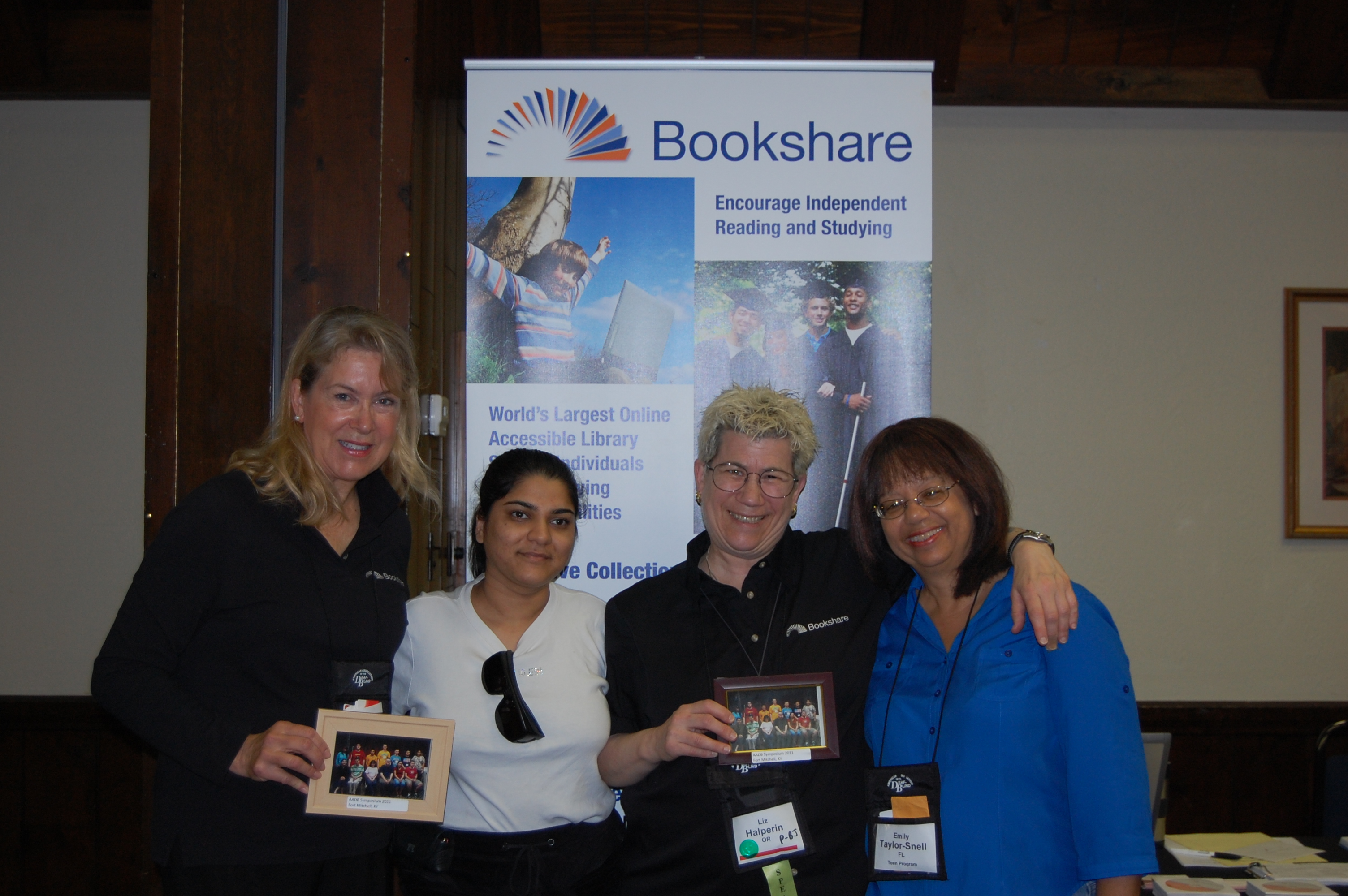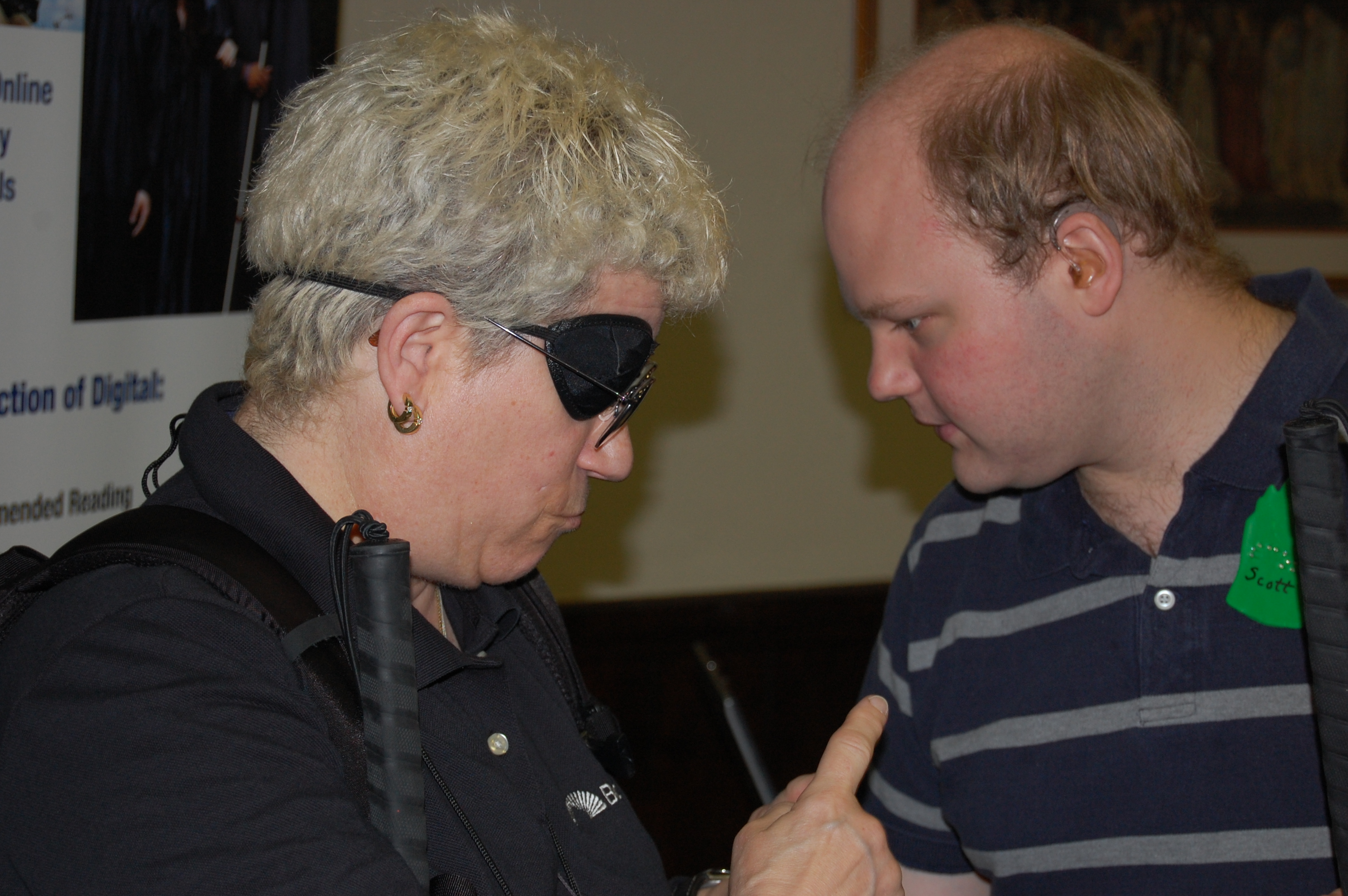
During the week of June 19 – 25, over 600 individuals participated at the American Association of the Deaf-Blind National Symposium – “The Future is in Our Hands”- in Ft. Mitchell, Kentucky. For Bookshare, it was the first time to be an exhibitor at this conference.
“Delegates” are association members who have combined hearing and vision losses and voting rights in the General Assembly meetings. Each had at least one accompanying SSP (Support Service Provider) to enable them to access their environments and make informed decisions. In other environments, SSPs only provide visual information, via sign language. In this specific conference’s mode, they also provided full interpreter services, be that close or tactile (hand over hand) sign language. (For tactile signers, 2 SSP/interpreters are required.) The SSPs provided Delegates with visual and environmental information, sighted guide services, and communication accessibility. All of the other participants at the conference were referred to as Observers, Family Members, Exhibitors, or other titiles.
The AADB Symposium (previously called AADB Conferences) are usually held every two years, but it had been five years since the last one due to financial reasons. The week-long event was packed with workshops on subjects ranging from Scott Davert’s (he works with the Helen Keller National Center for Deaf-Blind Youths & Adults in New York, NY) session on the inaccessibility of the Digital Talking Book program from the National Library Service to “Bapin’s Lab” – an ongoing, hands-on demonstration of the newest tech gadgets including Apple iOS access via braille/speech/magnification.

Also at the Symposium were National Public Radio (NPR) and the Helen Keller National Center (HKNC) who are working collaboratively to develop and design a captioned braille radio for people who are deaf-blind. The accessible radio was demonstrated to allow those who are deaf-blind to receive instant news and emergency information. NPR also hosted private sessions where skilled braille users were able to test a prototype of the captioned braille radio. Exciting – and life-saving! –technology.
Bookshare’s deaf-blind Contact, Liz Halperin, who is herself deaf-blind and long-time AADB member, presented a “Comparison of Three Digital Book Programs for Braille Readers” and was warmly welcomed as a participant at the Teen/Young Adults Program on Transition.
Of the many exhibitors at the Symposium, one of Bookshare’s AT partners, Humanware, stood out for its long-standing work with the deaf-blind community. Dominic Gagliano and Jim Halliday were given a special award for their pioneering work on the Deaf-Blind Communicator by the AADB President.
The National Consortium on Deaf-Blindness (NCDB) (www.nationaldb.org) publication, Perspectives, was released that week to coincide with the Symposium. The issue included an article by Liz Halperin and Bookshare’s Education Program Manager, Kristina Cohen, on how Bookshare works for the Deaf-Blind population.
Perspectives is an international journal and free publication to over 4000 subscribers with articles, essays, and announcements about topics related to people who are deaf-blind. NCDB runs multiple programs and projects, many funded by the Office of Special Education Programs.
I was interested to learn that people who are deaf-blind have many different ways to communicate. They use sign language (adapted to fit their visual field), tactile sign language (hand over hand with many modifications), tracking (holding the wrists of a signer so they know where to look), tactile fingerspelling, print-on-palm, Braille, speech, and speech reading, listening via hearing aids, cochlear implants, and many Assistive Listening Devices. The communication methods vary with each person, depending on the causes of their combined vision and hearing loss, their background and educational history, and many other variables, including time of day and the environment of the moment. Most deaf-blind people have several modes of communication to pull from their “tool box” at any given time.
Deaf-blind people use many types of technology and equipment in their daily lives. Examples include mobility canes or guide dogs, closed circuit televisions (CCTV), Braille, Braille TTYs, TTYs with large visual displays, and Braille or large print watches or clocks, to name only a few. Bookshare is the best source of books for people who are deaf-blind – books from RFB+D are inaccessible and the NLS does not have the robust catalogue of titles Bookshare has.
Last January, I began to learn American Sign Language so that I would be able to communicate – if only in a limited way – with some of the people that came to the Bookshare table. Our colleague, Liz, created a name sign for “Bookshare” – the word “book” and the word to “distribute” – it was exciting to see people using the sign in their conversations!
While this was Bookshare’s first time as an exhibitor at the AADB Symposium, it will not be the last. For people who read materials in braille or large print, it is a tremendous resource.

Good to hear that we can see Bookshare on the next Symposium as well.